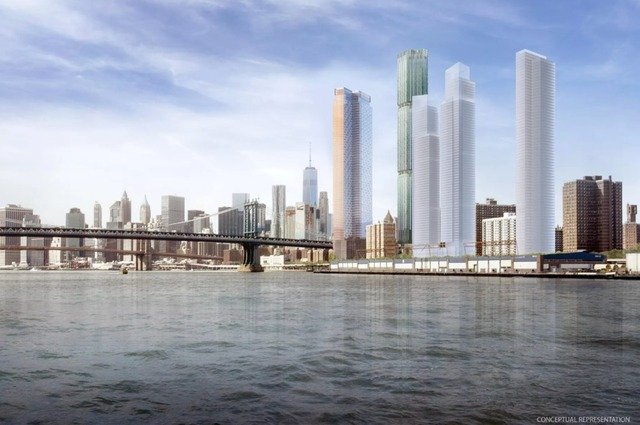Court Decision Throws Another Wrench Into Supertall Plan At Two Bridges
July 19, 2019, 2:40 p.m.
As a result of the ruling, JDS now needs to negotiate development rights with a neighboring lease holder in order to build a planned 1,008-foot residential tower.

The proposed Two Bridges development.
Dealing another blow to the controversial Two Bridges mega development in Lower Manhattan, a panel of state appellate judges has ruled that one of the project’s developers must seek consent from a storefront leaseholder before proceeding with a planned supertall.
Luxury residential developer JDS had proposed the tallest of what is slated to be four high-rise towers near the waterfront in the Lower East Side and Chinatown. In a creative feat of zoning and engineering, the planned residential project at 247 Cherry Street would rise 1,008 feet in a stilt-like design above an existing 10-story senior apartment building and a neighboring one-story brick building at 235 Cherry Street whose ground lease is held by a team of competing developers, Roy Schoenberg and Gary Spindler.
Schoenberg and Spindler, who are behind the entity known as Cherry Street LLC that sued JDS over its project, have 25 years remaining on the ground lease of 235 Cherry Street, a vacant building formerly home to Rent-a-Center and a Pathmark pharmacy. The two developers originally had their designs on building a 300,000-square-foot project, but they were unsuccessful in their attempt to buy the property. Their legal wrangling with JDS dates back to at least 2016.
Now, as a result of the ruling, Schoenberg and Spindler have leverage over JDS, which needs to negotiate development rights with them in order to build its tower.
The judgment, which was handed down last week, does not apply to the other Two Bridges developers, a joint venture of L+M Development Partners and CIM Group, and Starrett Development. In December, despite huge protests from the community, the city Planning Commission voted to approve the $4.5 billion development. Altogether, the plan consists of over 2,700 new residential units, of which 25 percent, or 690 units, would be affordable housing.
But the fate of the entire mega project is unclear. Immediately following the commission’s approval, the city and developers were slapped with three lawsuits from community groups. Among the arguments was that a project of this scope and scale should have been forced to undergo a public approval process. In June, a state Supreme Court extended a temporary halt on the Two Bridges plan and indicated that he was leaning toward withdrawing its permit.
“These are huge towers,” said Judge Arthur Engoron. “I’ve lived in the city my whole life. You can’t just do this because the zoning allows it. I just can’t believe this is the case.”
The judge's formal written decision is expected to be issued next month.
A spokesperson for JDS did not immediately respond to a request for comment.
Meanwhile, Paula Segal, an attorney on one of the lawsuits against the broader Two Bridges plan, said the Lower East Side groups she represents have already initiated conversations with the Department of City Planning on an application to change the zoning in the neighborhood by creating a special district.
"We’re working on changing the underlying zoning so that when a building is built it fits into the neighborhood and has a program of affordable housing," said Segal, who works at the legal advocacy group TakeRoot Justice.
She said the groups hope the city will start the public review process for their proposal by the end of year.